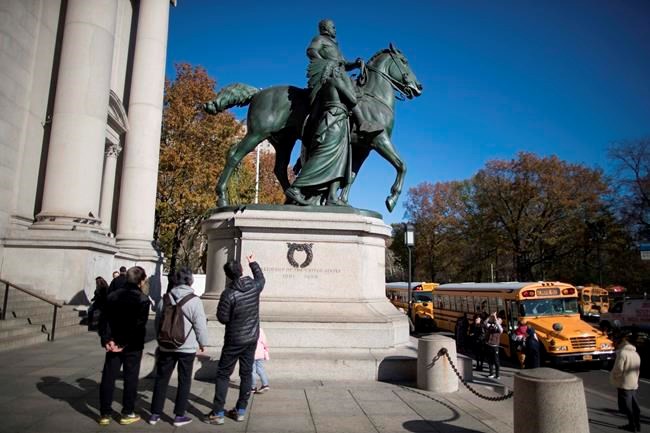NEW YORK — The American Museum of Natural History will remove a prominent statue of Theodore Roosevelt from its entrance after years of objections that it symbolizes colonial expansion and racial discrimination, Mayor Bill de Blasio said Sunday.
The bronze statue that has stood at the museum's Central Park West entrance since 1940 depicts Roosevelt on horseback with a Native American man and an African man standing next to the horse.
“The American Museum of Natural History has asked to remove the Theodore Roosevelt statue because it explicitly depicts Black and Indigenous people as subjugated and racially inferior," de Blasio said in a written statement. "The City supports the Museum’s request. It is the right decision and the right time to remove this problematic statue.”
Taking to Twitter, President Donald Trump objected to the statue's removal.
“Ridiculous, don’t do it!” he tweeted.
The museum's president, Ellen Futter, told the New York Times that the museum's “community has been profoundly moved by the ever-widening movement for racial justice that has emerged after the killing of George Floyd.”
“We have watched as the attention of the world and the country has increasingly turned to statues as powerful and hurtful symbols of systemic racism," Futter told the Times.
Officials said it hasn't been determined when the Roosevelt statue will be removed and where it will go.
“The composition of the Equestrian Statue does not reflect Theodore Roosevelt's legacy,” Theodore Roosevelt IV, a great-grandson of the president, said in a statement to the Times. “It is time to move the statue and move forward.”
Futter said the museum objects to the statue but not to Roosevelt, a pioneering conservationist whose father was a founding member of the institution and who served as New York's governor before becoming the 26th president. She said the museum is naming its Hall of Biodiversity for Roosevelt “in recognition of his conservation legacy.”
In 2017, protesters splashed red liquid on the statue's base to represent blood and published a statement calling for its removal as an emblem of “patriarchy, white supremacy and settler-colonialism.”
The Associated Press




